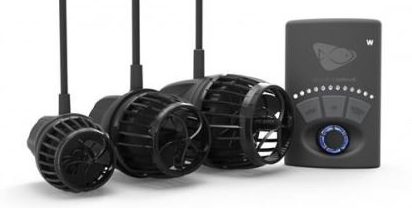Why good water flow is important for an aquarium
It is well established that good water movement is important in salt-water reef tanks where anemones need to have some wave action to move food around over them but the benefit to freshwater setups might be less obvious. In a live aquarium plant setup with injected CO2, having the CO2 distribute evenly means all the plants will get their share. In perfectly still water, dissolved CO2 gas does not effectively distribute itself by diffusion so a source of water movement is necessary. Providing a powerhead is a good way to get the water movement you need.
How to circulate aquarium water in a nanotank
There are lots of good choices in powerheads to push water around, but options are considerably restricted for an aquarium as small as 40 L. Mostly this is because the powerheads are designed to push a lot of water, possibly with more than one in a given tank, so getting something that works well without blasting the inhabitants all over the place is a challenge. Some potential options:
Of these, the Ecotech VorTech design is unique because the propeller that sits in the “wet side” mount adheres magnetically and spins by coupling magnetically to the “dry side” component that has all the electrical pieces. That means no submerged electrical components, which is a good thing in the general case, but also means there is no need for an electrical wire to have to work up through the top of the tank. Since the top of the Oase is not open, this is a big plus. The downside to the VorTech is the cost… these puppies are expensive, running to £250+. The conventional wisdom on these is to pick them up second hand on Ebay, so that’s what I did. It was still expensive, but it did take some of the sting out.
The VorTech has lots of great programmable modes, including constant on, short pulse mode, long pulse mode (they call it ‘gyre mode’), and modes that simulate a lagoon (gentle), a reef (chaotic) and a tidal swell (both gentle and chaotic periods). There are 12 speeds available. I wound up going for gyre mode, where the powerhead alternates running at the lowest setting for 2 minutes, with running at the second lowest setting for 2 minutes. That pushes lots of water around, provides some variety, and doesn’t go too crazy smashing things into other things.
Do fish like moving water?
Interestingly, the behaviour of the fish changed quite dramatically with the water movement provided by the VorTech. Previously the tetras would mostly lazily occupy the upper levels of the tank and the barbs would lazily occupy the middle levels of the tank. With the flow on, both tetras and barbs spend a lot of time at the lower levels, surfing on the current over the bottom. The five banded barbs will sometimes “swim upstream”, turn around and float downstream, then turn around and swim upstream again. I’ve seen them repeat this several times. They must be doing this because they want to since even with the powerhead there are some relatively calm regions that can be found in the tank. Occasionally the fish will move up to the middle water levels, but don’t really do the upper levels anymore, except at feeding time. They clearly know when it’s getting close to feeding time (when the lights go off in the evening) and collect expectantly near the surface. Since there’s no external filter on the Oase, I don’t have to worry the VorTech will push the food into the filter, so the flakes sail around crazily and the fish go after those vigorously, which is entertaining to watch.
Rummy nosed tetras are native to rivers, where flow is to be expected. The barbs are native to streams and swamps, so not strangers to flowing water either. The live plants benefit from well-distributed nutrients and CO2. I haven’t noticed a particular change with algae in terms of either an obvious increase or decrease. Overall, the moving water seems like a good idea.

